Peasants
Peasants. A social class engaged largely in subsistence agriculture. Peasants have played an unusually important part in the history of Ukraine. Not only did they make up the overwhelming majority of the Ukrainian population until the 1930s, but they also contributed much to the preservation and development of Ukrainian culture. One of the peculiarities of the peasants as a social stratum is the stability of their way of life and a conservative attitude toward traditions, language, and faith—in short, their fostering of national and ethnic characteristics, some of which extend back to pre-Christian times and even to Indo-European roots. That peculiarity of the peasants and their cultural life was particularly important for the Ukrainian nation, which had been subdued by powerful neighbors and, particularly in the case of the upper classes (nobility and higher clergy) and the urban strata (burghers), exposed to assimilatory influences. The peasants served as a major source for regeneration in the 19th century, when the Ukrainian literary language (see Standard Ukrainian) was reconstructed on the basis of the peasant vernacular, and the traditions of village life were mined for the components of a national culture.
The peasants of Kyivan Rus’ arose in conjunction with the new state system that replaced the disintegrating ancestral social structure of the Slavic tribes. The peasants of Rus’ were grouped in relatively autonomous settlements, where they worked together to cultivate land using slash-and-burn techniques. The vast majority of peasants fell into the category of smerds. The smerds were of two types, either entirely free or dependent. The free peasants formed the largest group and enjoyed the rights of free persons. The dependent smerds, whose numbers grew with princely gifts of land to servitors, lived on princely and boyar lands, paying rents primarily in kind (see quitrent), but money and labor rents (corvée) were also known. The smerds were not, however, serfs or slaves. A smerd could become a zakup, that is, an indentured laborer to a lord. That status was temporary, however; once the zakupy had paid off their debts, they were free again.
After the Mongol invasion (1240) and the passage of Ukrainian lands under Polish and Lithuanian rule (mid-14th century) the peasants' rights were further restricted and their rents increased, until they lost their personal freedom and became serfs wholly dependent on the landowners. That enserfment was part of the so-called second serfdom that characterized the economy of Eastern Europe beginning in the late 15th century, precisely when serfdom was dying out in Western Europe. Surveyors divided up the arable land and established demesnal estates (see Filvarok) on which the peasants had to labor as a form of rent to the landlords; peasants also had their own, much smaller plots, from which they eked out their sustenance. Ukrainian peasants resisted enserfment (eg, the Mukha rebellion in 1490–2), but they were forced to submit. After the Union of Lublin (1569), when all Ukrainian lands formerly under Lithuanian rule passed to the jurisdiction of the Polish Crown, the Ukrainian peasants were encouraged to colonize the relatively empty southwestern and eastern territories of Ukraine. Oppression in Ukraine's heavily populated west led to a great eastward movement of population. The burdens of serfdom were much reduced in eastern Ukraine, both as a natural result of the population (and hence labor) shortage and as part of a deliberate policy to attract colonists. At the end of the 16th century, for example, peasants with one lan of land in Chervona Rus’ (Galicia) owed four or five days' labor on the filvarok; in Volhynia and the region west of Kyiv they owed two or three days; and in Left-Bank Ukraine and the Bratslav region they paid money rent only. Peasant obligations were steadily increased, however, and by the 1640s, peasants in Volhynia and the Kyiv region worked five days on the lord's estate, and peasants in Left-Bank Ukraine and in the Bratslav region worked one or two days.
Ukrainian serfs sometimes ran away illegally from their owners' estates and headed for the steppe of Southern Ukraine and Slobidska Ukraine, which were in immediate danger of Tatar raids. There they became Cossacks. Cossack uprisings in the early 17th century often expressed opposition to serfdom. The Cossack-Polish War of 1648–57, in which peasants joined the Cossack forces, resulted in the abolition of serfdom in the emergent Hetman state. But the Cossack starshyna began appropriating freeholders' land and reimposing labor and other rents on the rank-and-file Cossacks. Around 1700 about a quarter of the population of Left-Bank Ukraine and Slobidska Ukraine, and by the 1730s about half, consisted of peasant serfs. The reintroduction of serfdom, albeit in mitigated form, engendered conflicts between the starshyna and rank-and-file Cossacks and contributed to the instability in Ukraine in the late 17th and early 18th centuries and to the ability of the Muscovite authorities to intervene in the internal affairs of the Hetman state.
In Right-Bank Ukraine, where the Cossack movement had been entirely suppressed by the early 18th century, serfdom was fully reinstituted. But because war and civil strife had depopulated that territory, the obligations of the serfs were not onerous in the first two decades of the 18th century. By the 1760s, however, the position of the Right-Bank peasantry had declined to perhaps its lowest point in history. The great discontent in the countryside fueled the haidamaka uprisings of the mid-18th century.
The Russian empress Catherine II formally reinstituted serfdom in Left-Bank Ukraine and Slobidska Ukraine in 1783. The conquest of the northern Black Sea littoral allowed her to extend serfdom to Southern Ukraine as well. Almost simultaneously with the reinstitution of serfdom Catherine dismantled the vestiges of Cossack autonomy, destroyed the Zaporozhian Sich, and resettled part of the Slobidska Cossack population in the Kuban. Her government also attracted foreign colonists, for the most part Germans and Serbs, to Southern Ukraine, where they formed a free and prosperous peasantry of the Western European type.
In the first half of the 19th century the serfs were the most abject, most oppressed class in the Russian Empire. Although the peasant hromada elected its own elders, who dealt with the bailiff and landowner, the gentry landowner had the right to try serfs, exile them to Siberia, send them to the army, and subject them to corporal punishment. Serfs could not marry without his permission, he could sell an entire family of serfs or individual family members, and he set the amount of work that the serf was obligated to perform. Laws limited his exercise of the last two powers. Paul I limited corvée obligations to three days a week and prohibited the sale of serfs without land in Ukraine. Naturally, abuses occurred, but only when he was exceptionally cruel or committed murder could a landowner be deprived of the right to his human property. The land was also considered to be entirely his property, and he had the right to decide all agricultural questions. The burdens of serfdom were greatest in Right-Bank Ukraine, where the majority of peasants were owned by landlords, and corvée prevailed. In Left-Bank Ukraine and Slobidska Ukraine state peasants, who were mainly descendants of Cossacks, predominated; they paid taxes, generally in money or in kind, to the state (see Poll tax). Serfdom was weakest in Southern Ukraine, which was newly conquered from the Crimean Tatars and relatively uncultivated; because of a labor shortage rents were less burdensome than elsewhere in Ukraine, and landlords often leased out land to tenant farmers. The prolonged existence of serfdom in the Russian Empire retarded its economic and social development, a situation that became obvious even to the ruling class after Russia's defeat in the Crimean War in 1856. Against the background of massive social unrest in the Russian and Ukrainian countryside, serfdom was abolished in the Russian Empire in 1861.
In Galicia, which passed under Austrian rule in 1772, the position of the peasantry improved as a result of the reforms of Empress Maria Theresa and Emperor Joseph II. The imperial authorities formally limited corvée to three days a week (although landlords found ways to circumvent the restriction), prohibited some particularly onerous forms of rent, took steps to make the peasants legal owners of the so-called rustical lands from which they supported themselves, restricted the traditional right of the noble landowner to inflict corporal punishment, permitted the peasants to lodge formal complaints against abuses by the landlords, and abolished personal servitude (Leibeigenschaft). The impact of those far-reaching reforms was undermined, however, by the entrenched power of the local Polish nobility and by the conservative reaction that gripped Austria after the outbreak of the French Revolution and the defeat of Napoleon Bonaparte. Peasant resistance to serfdom, often taking the form of refusal to perform labor obligations, mounted in the first half of the 19th century, and soon after the Revolution of 1848–9 in the Habsburg monarchy broke out, serfdom was abolished.
Serfdom was also abolished in Habsburg-ruled Bukovyna and Transcarpathia in 1848. Peasant discontent in those regions had been great in the early 19th century, because the position of the serfs had declined tremendously in spite of the reforms of Joseph II. The reason for the decline was Austria's annexation of Galicia; the intense exploitation of the peasantry, characteristic of the Polish nobility there, proved an attractive model for the Magyar and Romanian gentry of Transcarpathia and Bukovyna. Bukovyna, which was administratively part of Galicia, had been the scene of mass peasant rebellion in the 1840s.
As a result of emancipation in Russian-ruled Ukraine, the peasants received their personal freedom, and part of the land was sold to the village communes (hromady), to be paid in installments over the course of 49.5 years at a rate of 5 percent a year. The reform was undoubtedly favorable to the peasantry, but because the peasants still did not become landowners, and because of antiquated farming techniques, agricultural production was retarded. Peasant holdings were small. The average size of a peasant household's landholding in Ukraine in 1905 was 7.3 ha. Holdings were largest in the less populated south (8.6 ha in Kherson gubernia, 10.2 in Katerynoslav gubernia, 16.2 in Tavriia gubernia), small in Left-Bank Ukraine and Slobidska Ukraine (5.4 ha in Poltava gubernia, 6.9 ha in Chernihiv gubernia, 8.0 in Kharkiv gubernia), and smallest in Right-Bank Ukraine (3.6 ha in Podilia gubernia, 4.2 in Kyiv gubernia, 3.6 in Volhynia gubernia). To satisfy their hunger for land about 1.6 million Ukrainian peasants emigrated to the Russian Far East between 1896 and 1914. Because of such a land shortage the villagers who remained in Ukraine started eyeing the disproportionate holdings of the gentry. Peasants cut wood from the landlords' forests without permission, allowed their livestock to graze on the meadows of the gentry, burned estates, and occasionally carried out attacks on the gentry and their representatives. The number of peasant riots recorded in the late 19th and early 20th century was greater than under serfdom. Populist revolutionaries supported the peasantry's acts of defiance and demanded the nationalization of land and its transfer to those who worked it. The idea found favor even among the prosperous elements of the peasantry, who could not buy land because of its high price. It was clear that the peasantry was being impoverished as a result of landlessness, direct and indirect taxes, and the redemption payments for land that remained from the time of emancipation. The Revolution of 1905 demonstrated that it was impossible to continue without radical changes.
The changes came in the form of the Stolypin agrarian reforms, which were introduced by the decree of 9 November 1906 and became law on 14 June 1910. The reforms gave great impetus to peasant migration to Siberia and Kazakhstan, where settlers were offered financial assistance, land, and exemption from taxes. At the same time remnants of serfdom were abolished in the village, including collective responsibility for repairing roads and billeting troops and the restrictions on the right of peasants to receive passports. The Stolypin reforms led to differentiation by economic status in the peasant population. The more active, prosperous segment of the population, some 10 to 15 percent, received the opportunity to improve their farms, consolidate their landholdings, use modern equipment, and broaden their market. Ukraine, which did not have a tradition of the repartitional commune (see Obshchina), adapted relatively well to the reforms, and individual peasant farms independent of the communes proliferated.
As a result of the emancipation in Austrian-ruled Ukraine, the peasants became free and owners of their rustical plots. They paid an indemnity to the landowners for the loss of labor and other rents until 1898. The decade following emancipation was marked by the struggle over servitudes, or rights to forests and pastures, but by the 1860s most of Galicia's and Bukovyna's forests and pastures had been awarded to the gentry. Throughout Habsburg-ruled Ukraine the peasantry faced land hunger. The size of the rustical plots had been reduced by the nobility in the decades preceding and during the abolition of serfdom, and because Ukrainian peasants customarily divided their land among all children, the average size of peasant landholdings declined inexorably. According to official statistics, at the beginning of the 20th century almost half the peasant holdings in Galicia and over half in Bukovyna were 2 ha or smaller. The land shortage was one of the factors motivating the large-scale emigration of peasants from Transcarpathia, Galicia, and Bukovyna to North America and elsewhere in the decades before the First World War. In the 1860s and 1870s the Austrian government introduced compulsory universal education in Galicia and Bukovyna; that measure, combined with the efforts of the Ukrainian national movement (particularly organizations such as Prosvita), raised the cultural level of the West Ukrainian peasantry. In Transcarpathia, however, the Magyar gentry restricted educational opportunities, in particular education in Ukrainian, and prevented the formation of a Ukrainian national movement with its own voluntary associations.
During the years of revolutionary upheaval, 1917–21, armed peasants on the former territory of tsarist-ruled Ukraine liquidated gentry estates, and those lands, as well as land owned by the government and sugar refineries, were redistributed among the peasantry. Peasants refurbished and improved their farms and increased their livestock. For the first time in many years Ukraine did not export huge quantities of grain. As a result, from 1916 to the spring of 1921 the number of livestock in Ukraine increased from 23.9 million to 31.1 million. Raids by Soviet surplus appropriation system detachments disturbed peasant agriculture as soldiers confiscated, without payment, grain and other produce that fell into their hands to feed the urban populations and the Red Army (see Grain procurement). In such circumstances the peasants did not rush to expand production, and in 1921 a catastrophe struck: the now stronger Soviet regime announced a higher demand for grain, and at the same time a drought hit Southern Ukraine and destroyed the harvest. Much of Soviet Ukraine (and Soviet Russia) suffered from famine (see Famine of 1921–3). In the same year the government recognized the need to change its agrarian policy and instituted the New Economic Policy, which amounted to a truce with the peasantry. The main point of the accord was the cessation of unpaid expropriations and the establishment of taxes, after the payment of which peasants could sell the products of their labor. The taxes were substantial, exceeding prerevolutionary ones, and they were supplemented by an indirect tax created by the price gap between industrial and agricultural goods. Nonetheless, the peasantry soon raised agricultural production to prewar levels. In that period peasants were permitted to lease land or equipment and to hire labor for productive purposes. The co-operative movement, especially consumer co-operatives, proliferated. The government put tax and political pressure only on the more prosperous peasants and on people connected with groups that had opposed the Bolsheviks, such as the Ukrainian Party of Socialist Revolutionaries, the partisan movement (see Partisan movement in Ukraine, 1918–22), the Army of the Ukrainian National Republic, and the anarchist forces of Nestor Makhno. Those people paid higher taxes and could not take part in the management of co-operatives, vote in elections, or be elected to village soviets. Many supplementary responsibilities also fell to their lot.
The social position of the peasantry changed fundamentally from what it had been in prerevolutionary times. Large farms virtually disappeared, and the number of landless peasants decreased. The peasantry became a uniform mass of agricultural producers and, to a degree, landowners. Their independence inspired a certain discomfort in the Bolshevik rulers. The Soviet government laid claim to absolute control over both production and ideology and distrusted the peasants both as petty independent producers and as keepers of national traditions. Its hostility to the peasants was manifested in the cruel manner in which collectivization was imposed in Ukraine in the late 1920s and early 1930s.
The goal of collectivization was the complete transformation of the economic and social circumstances of the peasantry. The peasants were deprived of the right to own land and the instruments of production; for a while they were also deprived of freedom of movement and were obliged to work in the fields without pay for fear of punishment. The most active and wealthy peasants were arrested and deported with their families to the north, and their property was confiscated. Collectivization took the form of unexpected attacks on the prosperous portion of the peasantry by detachments of workers, Komsomol members, Communist Party members, and activists of the Committees of Poor Peasants. Everyone else was forced to enter the collective farms under threat of being repressed as kulaks. Collective farming turned out to be extremely inefficient; the inefficiency was exacerbated by the peasants' passive mass resistance to collectivization, a resistance that included slaughtering their own animals. In 1932–3 the Soviet government created a famine to quell resistance. All grain and most remaining livestock were taken from the peasants, and the confiscation was accompanied by a law proclaiming the death penalty for any theft of food from a collective farm or state farm. By the summer of 1934, 54 percent of the villagers of Ukraine were without livestock, 64.7 percent had no cows, and 95.4 percent had no pigs. Several million peasants died, and the rest were forced to submit.
Collectivization and the Famine-Genocide of 1932–3 destroyed the peasantry as a social stratum. The peasants lost not only their land but their personal freedom and were forced to labor out of fear of punishment and death by starvation. Material incentives were eliminated, and the productivity of labor naturally fell. As a result of collectivization not only the means of agricultural production but also the social position and psychology of the rural inhabitants changed. To a significant degree they lost their love for the land and their habit of working on it.
The peasants in interwar Western Ukraine, divided among Poland, Czechoslovakia, and Romania, escaped collectivization in the 1930s and the accompanying famine. Under Polish and Romanian rule their position seems to have declined relatively from the late Austrian period. The Polish and Romanian regimes undertook land reforms that did nothing to improve the peasants' position. Estates that were divided in Ukrainian-inhabited areas were generally distributed among ethnic Polish and Romanian colonists. Because of immigration quotas in the United States and Canada, the traditional solution to rural overpopulation, emigration to North America, virtually ceased to play a role. The Great Depression of the 1930s increased the misery of the peasantry. The only positive development was the rapid growth of the co-operative movement, which provided increased and better opportunities for the peasantry to market surplus agricultural produce, particularly dairy products and eggs. In Transcarpathia the Ukrainian peasantry remained very poor, but the reformist Czechoslovak regime introduced elementary education in the local language for peasant children and implemented a land reform that, although slow and modest, benefitted Ukrainian peasants rather than non-Ukrainian colonists. As a result of the Second World War, Western Ukraine passed under Soviet rule, and by the mid-1950s the peasant farms there were completely collectivized.
In the postwar period the production of grain and nonfood crops (eg, cotton and flax) and, to some extent, animal husbandry were the responsibility of the collective farms. A portion of the animals, however, remained the personal property of the collective farmers. In addition each village household had a minute private plot around its house, which fed its members and provided potatoes and vegetables not only for the villagers but for the city as well. From that plot the peasant was supposed to supply the government with milk and meat and pay taxes. For a while it seemed that the system was producing foodstuffs successfully. Nikita Khrushchev improved the collective farmers' lot by substantially raising their pay, by gradually restoring their right to move about the country, and by introducing at least a small level of retirement benefits for collective farmers. At the same time huge expanses of virgin lands were colonized, and agricultural production actually rose somewhat. In the 1970s and 1980s, however, the food supply worsened noticeably, because the collective farms could no longer feed the population. One of the main causes of that circumstance was the fall in labor productivity on the private plots. The new generation of peasants raised solely in the collective-farm system turned out to be incapable of productive labor. Young people went off to study or moved away after their military service to work in the cities. The collective-farm peasantry has even taken on the characteristics of an age cohort, consisting more and more of the elderly.
(See also Agriculture, Feudalism, Land tenure system, Peasant strikes in Galicia and Bukovyna, and Slavery. For various peasant categories in the feudal era, see Common peasants, Economic peasants, Horodnyk, Khalupnyk, Kholop, Komornyk, Landless peasants, Nepokhozhi peasants, Otchychi, Pokhozhi peasants, Poplechnyk, Possessional peasants, Pripisnye peasants, Rank peasants, Siabry, Smerd, Starostvo peasants, and Tributary peasants.)
BIBLIOGRAPHY
Slabchenko, M. Khoziaistvo Getmanshchiny v XVII–XVIII stoletiiakh, 2 vols (Odesa 1922–3)
Iurkevych, V. Emigratsiia na skhid i zaliudnennia Slobozhanshchyny za B. Khmel’nyts’koho (Kyiv 1932)
Mytsiuk, O. Narysy z sotsiial’no-hospodars’koï istoriï Pidkarpats’koï Rusy, 2 vols (Prague 1936, 1938)
Grekov, B. Krest’iane na Rusi s drevneishikh vremen do XVII veka, 2nd rev edn, vol 1 (Moscow 1952)
Herasymenko, M. Ahrarni vidnosyny v Halychyni v period kryzy panshchynnoho hospodarstva (Kyiv 1959)
Leshchenko, N. Krest’ianskoe dvizhenie na Ukraine v sviazi s provedeniem reformy 1861 goda (60-e gody XIX st.) (Kyiv 1959)
Blum, J. Lord and Peasant in Russia from the Ninth to the Nineteenth Century (Princeton 1961)
Markina, V. Magnatskoe pomest’e Pravoberezhnoi Ukrainy vtoroi poloviny XVIII v. (sotsial’no-ekonomicheskoe razvitie) (Kyiv 1961)
Rozdolski, R. Stosunki poddańcze w dawnej Galicji, 2 vols (Warsaw 1962)
Boiko, I. Selianstvo Ukraïny v druhii polovyni XVI–pershii polovyni XVII st. (Kyiv 1963)
Myshko, D. Sotsial’no-ekonomichni umovy formuvannia ukraïns’koï narodnosti (stanovyshche selian i antyfeodal’ni rukhy na Ukraïni v XV–pershii polovyni XVI st.) (Kyiv 1963)
Diadychenko, V.; Kompaniiets’, I; et al (eds). Istoriia selianstva Ukraïns’koï RSR, 2 vols (Kyiv 1967)
Robinson, G.T. Rural Russia under the Old Regime: A History of the Landlord-Peasant World and a Prologue to the Peasant Revolution of 1917 (Berkeley and Los Angeles 1967)
Stashevskii, E. Istoriia dokapitalisticheskoi renty na Pravoberezhnoi Ukraine v XVIII–pervoi polovine XIX v. (Moscow 1968)
Markina, V. Krest’iane Pravoberezhnoi Ukrainy: Konets XVII–60-e gody XVIII st. (Kyiv 1971)
Leshchenko, M.; et al (eds). Selians’kyi rukh na Ukraïni, seredyna XVIII–persha chvert’ XIX st.: Zbirnyk dokumentiv i materialiv (Kyiv 1978)
Beauvois, D. Le Noble, le serf, et le révizor: La noblesse polonaise entre le tsarisme et les masses ukrainiennes, 1831–1863 (Paris 1986)
Edelman, R. Proletarian Peasants: The Revolution of 1905 in Russia's Southwest (Ithaca, NY 1987)
Himka, J.-P. Galician Villagers and the Ukrainian National Movement in the Nineteenth Century (Edmonton 1988)
Hryniuk, S. Peasants with Promise: Ukrainians in Southeastern Galicia, 1880–1900 (Edmonton 1991)
Graziosi, A. The Great Soviet Peasant War: Bolsheviks and Peasants, 1917–1933 (Cambridge, Mass 1996)
Alexander Babyonyshev, John-Paul Himka
[This article originally appeared in the Encyclopedia of Ukraine, vol. 3 (1993).]







